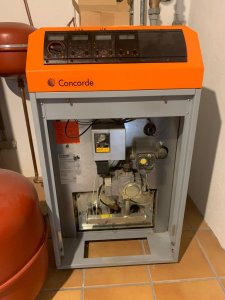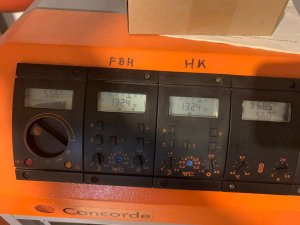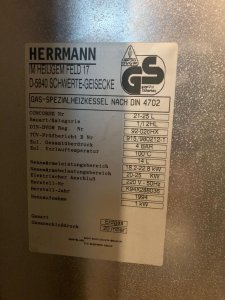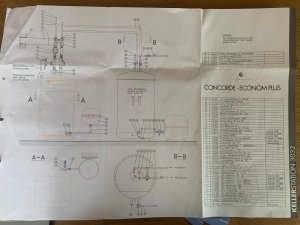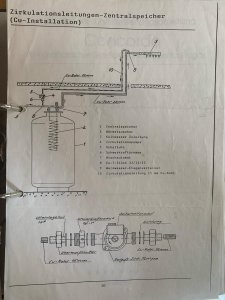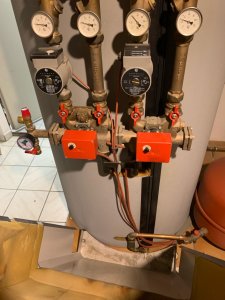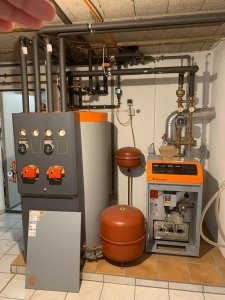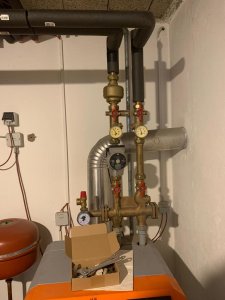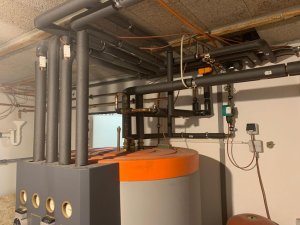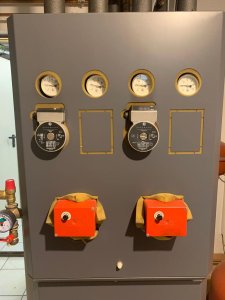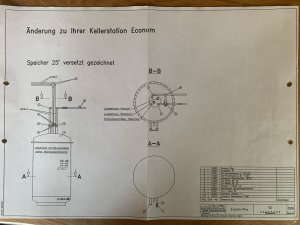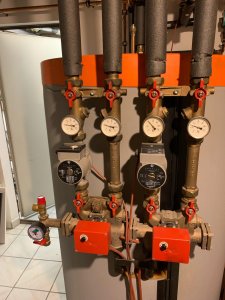sundoo
Threadstarter
- Mitglied seit
- 21.04.2022
- Beiträge
- 16
Hallo,
Es tut mir leid, meine schriftlichen Deutschkenntnisse sind noch nicht so gut, daher schreibe ich dies auf Englisch und verwende Google Translate.
Ich habe einen weiteren Beitrag geschrieben, in dem ich beschreibe, dass ich eine alte Gasheizung habe und gerne eine Wärmepumpe in die Gleichung einbauen würde.
 www.heizungsforum.de
www.heizungsforum.de
Mir war klar, dass die Angebote, die ich vom Heizungsspezialisten bekam, Unsinn waren. Wegen der Energiekrise versuchte er, reich zu werden.
Ich möchte jetzt experimentieren, indem ich eine Wärmepumpe in meinen bestehenden Kreislauf einbaue. Ich habe keinerlei Kenntnisse über Heizungsanlagen oder Wärmepumpen im Allgemeinen. Ich bin IT-Ingenieur, habe aber in letzter Zeit viel gelesen und verstehe die Funktionsweise dieser Systeme recht gut.
Ich habe jetzt ein gutes Verständnis für die Funktionsweise meines 30 Jahre alten Gaskessels und würde gerne mit dem Experimentieren beginnen, indem ich eine Wärmepumpe hinzufüge und versuche, einen Teil meiner Wärme damit zu erzeugen. Ich würde „die nächsten 1-2 Jahre damit spielen“ und hoffentlich irgendwann ganz auf die Wärmepumpe umsteigen.
Ich habe mehrere Bilder meiner Heizungsanlage beigefügt und hier einige Details:
1. Das Heizsystem ist heute ein Herrmann Concorde Gaskessel (21-25L).
2. Es ist an einen 600-Liter-Pufferspeicher angeschlossen, der zwei Heizkreise versorgt: einen für Heizkörper und einen für die Fußbodenheizung.
3. Im Pufferspeicher befindet sich ein Wärmetauscher, der zur Trinkwassererwärmung dient (auf den Bildern von oben kommend)
4. Nach meinem Verständnis erhitzt der Boiler das Wasser auf 70 Grad Celsius und leitet es in den Pufferspeicher. Die Rücklauftemperatur aus dem Pufferspeicher beträgt 56 Grad
Wenn Sie bis hierhin gelesen haben – vielen Dank. Hier kommt die Hauptfrage:
Ich möchte in diesen Kreislauf eine Wärmepumpe einbinden, die einen Teil der Erwärmung des Wassers für den Pufferspeicher übernimmt.
Die Fragen lauten wie folgt:
1. Gibt es eine Möglichkeit, diese Heizungspumpe anzuschließen, ohne das bestehende System zu „stören“? Idealerweise nehme ich einen Monoblock, den ich draußen aufstelle, und schließe ihn an das System an, damit er das Wasser vorwärmt, bevor es in den Gaskessel gelangt.
2. Mir ist bewusst, dass die Wärmepumpe nur dann effizient arbeiten kann, wenn eine Unter- oder Überlastung vermieden wird. Lassen wir die Wahl der Wärmepumpe vorerst außer Acht.
3. Muss ich das System entlüften, um die Wärmepumpe zu installieren?
4. Gibt es Bedenken hinsichtlich der vorhandenen Gaskesselelektronik? Heutzutage gibt es eine Reihe von Temperatursensoren rund um das System sowie einige Steuerungen für die Pumpen und verschiedene Motoren. Ich denke, die können so bleiben, wie sie sind.
5. Gibt es sonst noch etwas, das ich beachten sollte?
Vielen Dank, ich bin bereit, Ihnen alle erforderlichen Informationen zur Verfügung zu stellen
Grüße
Alex
Es tut mir leid, meine schriftlichen Deutschkenntnisse sind noch nicht so gut, daher schreibe ich dies auf Englisch und verwende Google Translate.
Ich habe einen weiteren Beitrag geschrieben, in dem ich beschreibe, dass ich eine alte Gasheizung habe und gerne eine Wärmepumpe in die Gleichung einbauen würde.
Hoffnungslosigkeit und wie die Heizungsexperten machen sich die Energiekrise zunutze
Zunächst muss ich mich entschuldigen, da mein Deutsch sehr schlecht ist. Dieser Beitrag wurde also ursprünglich auf Englisch verfasst und dann in Google übersetzt. Vor einiger Zeit haben wir ein Haus in Deutschland (Rheinland-Pfalz) gekauft, aber zufälligerweise verfügt es über eine sehr alte...
Mir war klar, dass die Angebote, die ich vom Heizungsspezialisten bekam, Unsinn waren. Wegen der Energiekrise versuchte er, reich zu werden.
Ich möchte jetzt experimentieren, indem ich eine Wärmepumpe in meinen bestehenden Kreislauf einbaue. Ich habe keinerlei Kenntnisse über Heizungsanlagen oder Wärmepumpen im Allgemeinen. Ich bin IT-Ingenieur, habe aber in letzter Zeit viel gelesen und verstehe die Funktionsweise dieser Systeme recht gut.
Ich habe jetzt ein gutes Verständnis für die Funktionsweise meines 30 Jahre alten Gaskessels und würde gerne mit dem Experimentieren beginnen, indem ich eine Wärmepumpe hinzufüge und versuche, einen Teil meiner Wärme damit zu erzeugen. Ich würde „die nächsten 1-2 Jahre damit spielen“ und hoffentlich irgendwann ganz auf die Wärmepumpe umsteigen.
Ich habe mehrere Bilder meiner Heizungsanlage beigefügt und hier einige Details:
1. Das Heizsystem ist heute ein Herrmann Concorde Gaskessel (21-25L).
2. Es ist an einen 600-Liter-Pufferspeicher angeschlossen, der zwei Heizkreise versorgt: einen für Heizkörper und einen für die Fußbodenheizung.
3. Im Pufferspeicher befindet sich ein Wärmetauscher, der zur Trinkwassererwärmung dient (auf den Bildern von oben kommend)
4. Nach meinem Verständnis erhitzt der Boiler das Wasser auf 70 Grad Celsius und leitet es in den Pufferspeicher. Die Rücklauftemperatur aus dem Pufferspeicher beträgt 56 Grad
Wenn Sie bis hierhin gelesen haben – vielen Dank. Hier kommt die Hauptfrage:
Ich möchte in diesen Kreislauf eine Wärmepumpe einbinden, die einen Teil der Erwärmung des Wassers für den Pufferspeicher übernimmt.
Die Fragen lauten wie folgt:
1. Gibt es eine Möglichkeit, diese Heizungspumpe anzuschließen, ohne das bestehende System zu „stören“? Idealerweise nehme ich einen Monoblock, den ich draußen aufstelle, und schließe ihn an das System an, damit er das Wasser vorwärmt, bevor es in den Gaskessel gelangt.
2. Mir ist bewusst, dass die Wärmepumpe nur dann effizient arbeiten kann, wenn eine Unter- oder Überlastung vermieden wird. Lassen wir die Wahl der Wärmepumpe vorerst außer Acht.
3. Muss ich das System entlüften, um die Wärmepumpe zu installieren?
4. Gibt es Bedenken hinsichtlich der vorhandenen Gaskesselelektronik? Heutzutage gibt es eine Reihe von Temperatursensoren rund um das System sowie einige Steuerungen für die Pumpen und verschiedene Motoren. Ich denke, die können so bleiben, wie sie sind.
5. Gibt es sonst noch etwas, das ich beachten sollte?
Vielen Dank, ich bin bereit, Ihnen alle erforderlichen Informationen zur Verfügung zu stellen
Grüße
Alex
Anhänge
-
83,1 KB Aufrufe: 34
-
74,3 KB Aufrufe: 44
-
115,5 KB Aufrufe: 49
-
210,2 KB Aufrufe: 34
-
201,2 KB Aufrufe: 32
-
172,3 KB Aufrufe: 37
-
103,7 KB Aufrufe: 43
-
75,3 KB Aufrufe: 37
-
90,5 KB Aufrufe: 35
-
61,2 KB Aufrufe: 42
-
171,4 KB Aufrufe: 32
-
201 KB Aufrufe: 34

